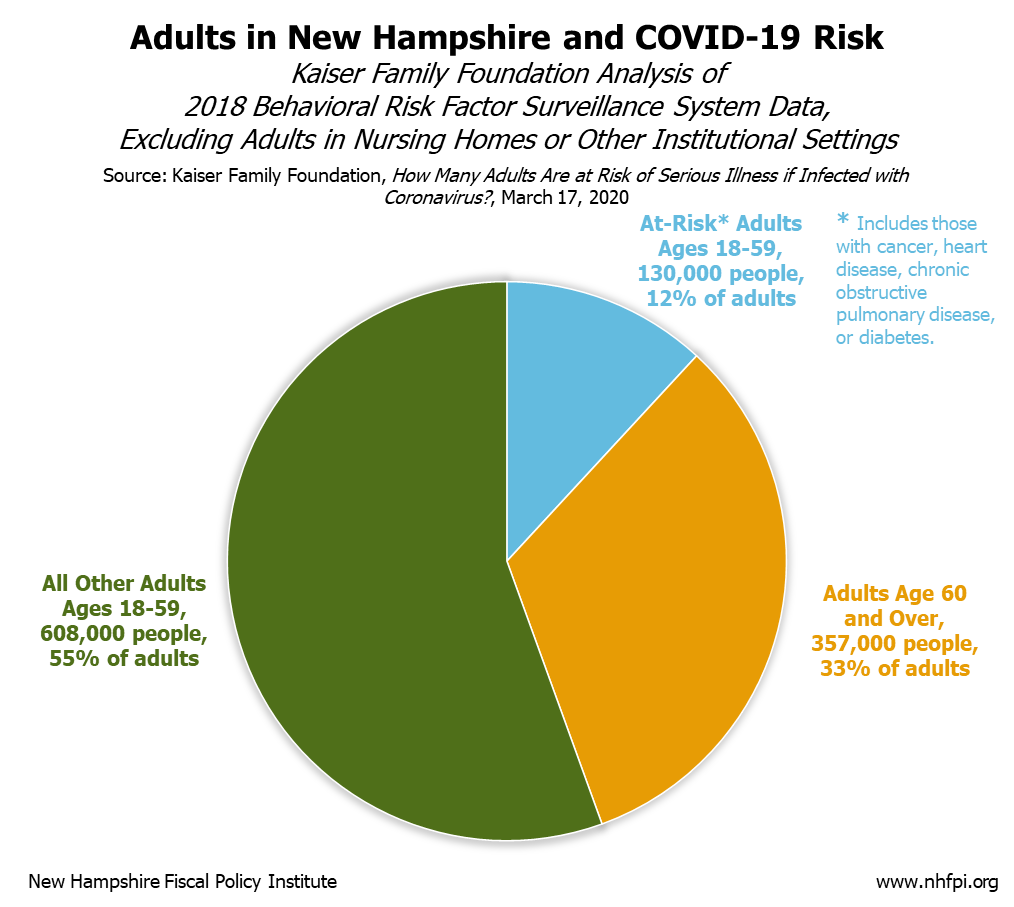New Hampshire’s population may be disproportionately vulnerable to more severe instances of COVID-19 due in part to the state’s older demographic. With higher estimated percentages of older adults and younger at-risk adults than the country as a whole, New Hampshire’s health care system may be especially strained to respond to this crisis.
Available information indicates certain groups are at higher risk of having serious cases of COVID-19. The U.S. Centers for Disease Control and Prevention identifies high risk groups as those who are older adults or those of all ages with severe underlying health conditions, such as heart disease, lung disease, and diabetes. About eight in ten reported deaths from COVID-19 in the United States have been adults age 65 years and older.
An analysis released March 17 by the Kaiser Family Foundation estimates the percentage of non-institutionalized adults for each state in 2018 who were ages 60 years or older or who were ages 18 to 59 years and had cancer, heart disease, chronic obstructive pulmonary disease, or diabetes. While the percentage of adults aged 18 and older, excluding those living in nursing homes or other institutional settings, identified as at risk nationwide was about 41 percent, the estimate for New Hampshire was over 44 percent, or about 487,000 residents. While the percentage of adults identified as at risk and aged 18 to 59 was higher in New Hampshire than in the nation as a whole, slightly under three quarters of all at-risk adults were ages 60 or over.
New Hampshire had a median age of approximately 43 years in 2018, while the median age for the United States as a whole was 38.2 years. About 18.1 percent of the state’s residents, approximately 246,000 people, were age 65 years or over in 2018, while the nationwide estimated portion was 16.0 percent. Several less urban counties in New Hampshire have higher median ages than the state overall, and some rural communities in the state have disproportionately high concentrations of older adults.
The 2019 novel coronavirus may create particular risks for individuals in nursing homes. New Hampshire’s nursing home occupancy rate, at 87 percent in 2017, was higher than the overall rate for the nation, suggesting a potentially higher chance of spreading this coronavirus within facilities.
Every state and resident will be challenged during the continuation of the COVID-19 crisis. The relative age of New Hampshire’s population suggests that the state may be more challenged than others in particular dimensions. Kaiser Family Foundation calculations indicate New Hampshire had fewer hospital beds per person in 2018 than the United States overall.
Delivering services to older adults at their homes is an important option, but the system providing those services to Medicaid recipients in New Hampshire was already under strain prior to this crisis, due in part to limited funding and a lack of workers to provide services. In March 2019, an NHFPI Issue Brief examined services delivered under the Choices for Independence Medicaid Waiver, which aims to provide long-term care for eligible adults of limited means in home- and community-based settings. Key agencies delivering this care reported that workforce shortages limited or prevented service provision in some situations. NHFPI analysis showed low-end wages for these occupations had not grown, and reimbursement rates for these services had fallen behind inflation. While more newly-unemployed workers may eventually be available to fill some unmet needs, those workers will require training, and the increased need for services may vastly outpace capacity.
Providing effective protection from the 2019 novel coronavirus to keep older and at-risk adults healthy, and delivering sufficient treatment for COVID-19 or any other ailments these adults may have during this time, will be very difficult tasks in the weeks and months ahead.
For more information on the COVID-19 crisis in New Hampshire, see NHFPI’s Common Cents blog.
– Phil Sletten, Policy Analyst

